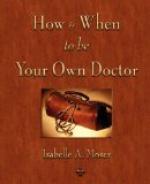One of the best aspects of using vitamins as though they were healing agents is that food supplements almost never have harmful side effects, even when they are taken in what might seem enormous overdoses. If someone with a health condition reads or hears about some vitamin being curative, goes out and buys some and takes it, they will at very least have followed the basic principle of good medicine: first of all do no harm. At worst, if the supplements did nothing for them at all, they are practicing the same kind of benevolent medicine that Dr. Jennings did almost two centuries ago. Not only that, but having done something to treat their symptoms, they have become patients facilitating their own patience, giving their body a chance to correct its problem. They well may get better, but not because of the action of the particular vitamin they took. Or, luckily, the vitamin or vitamins they take may have been just what was needed, raising their body’s vital force and accelerating the body’s ability to solve its problem.
One reason vitamin therapies frequently do not work as well as they might is that, having been intimidated by AMA propaganda that has created largely false fears in the public mind about harmful effects of vitamin overdoses, the person may not take enough of the right vitamin. The minimum daily requirements of vitamins and minerals as outlined in nutrition texts are only sufficient to prevent the most obvious forms of deficiency diseases. If a person takes supplements at or near the minimum daily requirement (the dose recommended by the FDA as being ‘generally recognized as safe’) they should not expect to see any therapeutic effect unless they have scurvy, beri beri, rickets, goiter, or pellagra.
In these days of vitamin-fortified bread and iodized salt, and even vitamin C fortified soft drinks, you almost never see the kind of life-threatening deficiency states people first learned to recognize, such as scurvy. Sailors on long sea voyages used to develop a debilitating form of vitamin C deficiency that could kill. Scurvy could be quickly cured by as little as one lime a day. For this reason the British Government legislated the carrying of limes on long voyages and today that is why British sailors are still called limeys. A lime has less than 30 milligrams of vitamin C. But to make a cold clear up faster with vitamin C a mere 30 mg does absolutely nothing! To begin to dent an infection with vitamin C takes 10,000 milligrams a day, and to make a life threatening infection like pneumonia go away faster might require 25,000 to 150,000 milligrams of vitamin C daily, administered intravenously. In terms of supplying that much C with limes, that’s 300 to 750 of them daily—clearly impossible.
Similarly, pellagra can be cured with a few milligrams of vitamin B3, but schizophrenia can sometimes be cured with 3,000 milligrams, roughly a thousand times as much as the MDR.




